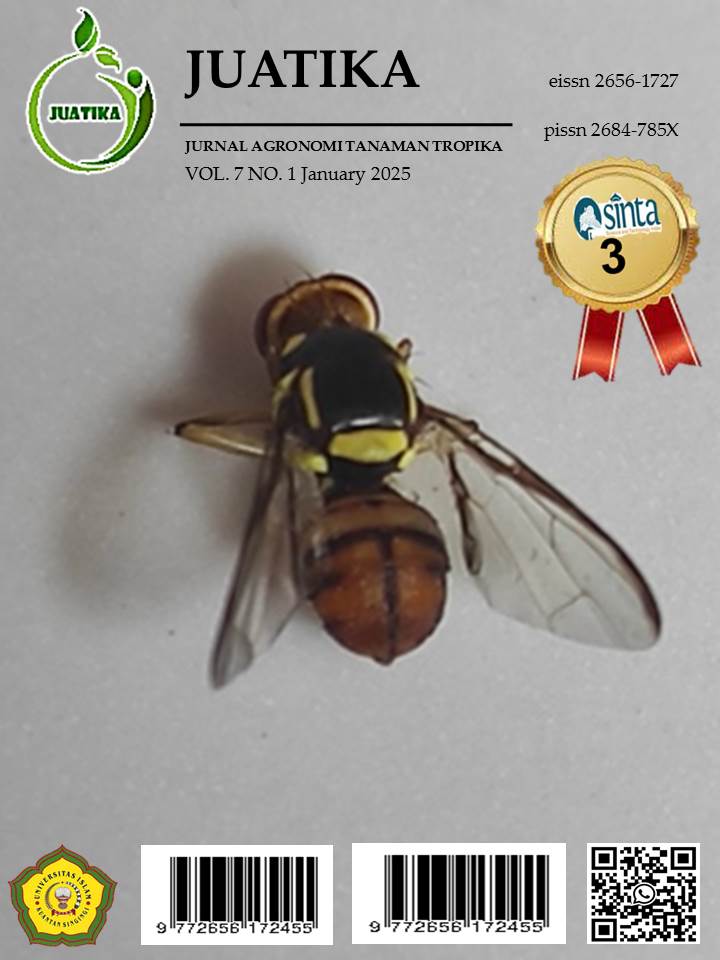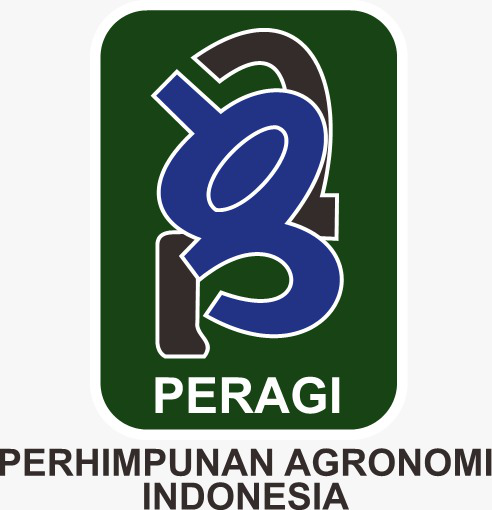Induction and Regeneration of Ginger Callus (Zingiber officinale) in Malaysia by Administration of 2,4 D and NAA
Abstract
Ginger (Zingiber officinale) is a valuable medicinal plant widely used in food and health industries. This study, conducted at the Malaysian Agricultural Research and Development Institute (MARDI) in September 2024, aimed to assess the impact of hormone concentrations on ginger callus yield and regeneration. The study employed a factorial design with two factors and three replications. The first factor involved MS 24-D media at doses of 0.5 mg/L, 1.0 mg/L, 3.0 mg/L, and 5.0 mg/L. The second factor included Naphthaleneacetic Acid (NAA) at doses of 0.5 mg/L, 1.0 mg/L, 3.0 mg/L, and 5.0 mg/L. Thidiazuron (TDZ) was also used as an additional growth regulator hormone to influence callus formation. The results indicated that growth regulator hormones such as 2,4-dichlorophenoxyacetic acid (24-D), NAA, and TDZ significantly enhanced callus formation efficiency, increasing callus weight. NAA treatment was particularly effective in increasing callus weight. The phenolic content analysis revealed that brown callus exhibited strong defense mechanisms due to a high accumulation of phenolic compounds. Phenolic compounds, known for their antioxidant and antibacterial properties, enhance plant resilience to environmental stress and hold promise for pharmacological applications. Incorporating TDZ in ginger culture demonstrates the potential for improving callus quality with high phenolic content, offering opportunities for agricultural applications.
Downloads
References
Abed-Ashtiani, F., Kadir, J., Nasehi, A., Hashemian-Rahaghi, S. R., & Golkhandan, E. (2016). Occurrence of leaf spot or blast on ginger (Zingiber officinale) caused by Pyricularia zingiberi in Malaysia. Plant Disease, 100(7), 1505. https://doi.org/10.1094/PDIS-01-16-0122-PDN
Alqamari, M., Thalib, B., & Fitra, S. (2020). Kajian media MS dengan penambahan auksin dan sitokinin terhadap pertumbuhan dan perkembangan kultur tunas aren (Arenga pinnata (Wurmb) Merr). Jurnal Pertanian Tropik, 7(1), 109–115. https://doi.org/10.32734/jpt.v7i1.April.3790
Anggraeni, D., Ismaini, L., Surya, M. I., Rahmi, H., & Saputro, N. W. (2022). Inisiasi kalus daun Talinum triangulare (Jacq.) Willd pada beberapa kombinasi konsentrasi zat pengatur tumbuh 2,4-Dichlorophenoxyatic Acid dan Benzyl Adenine. Agrikultura, 33(3), 276–288. https://doi.org/10.24198/agrikultura.v33i3.40540
Anggraito, Y. U., Susanti, R., Iswari, R. S., Yuniastuti, A., Lisdiana, L., WH, N., Habibah, N. A., & Bintari, S. H. (2018). Metabolit Sekunder dari Tanaman: Aplikasi dan Produksi. Fakultas Matematika dan Ilmu Pengetahuan Alam Universitas Negeri Semarang.
Arifin, A. Z., Hidayanto, F., & Mahfud, R. I. (2022). The effectiveness of substances in growth regulators on growth of root cutting of mother-in-law’s tongue leaves (Sansevieria trifasciata). Jurnal Agronomi Tanaman Tropika (JUATIKA), 4(1), 139–146. https://doi.org/10.36378/juatika.v4i1.1780
Bhojwani, S. S., & Dantu, P. K. (2013). Plant tissue culture: An introductory text. https://doi.org/10.1007/978-81-322-1026-9
Chen, Y. M., Huang, J. Z., Hou, T. W., & Pan, I. C. (2019). Effects of light intensity and plant growth regulators on callus proliferation and shoot regeneration in the ornamental succulent Haworthia. Botanical Studies, 60(10), 1–8. https://doi.org/10.1186/s40529-019-0257-y
Durroh, B., & Winarti, Y. (2020). Pemanfaatan air kelapa dan aplikasi pupuk organik untuk merangsang pertumbuhan bibit tebu G3 hasil kultur jaringan. Agro Bali: Agricultural Journal, 3(1), 21–27. https://doi.org/10.37637/ab.v3i1.415
Helmalia, A. W., Putrid, P., & Dirpan, A. (2019). Potensi rempah-rempah tradisional sebagai sumber antioksidan alami untuk bahan baku pangan fungsional. Canrea Journal: Food Technology, Nutrition, and Culinary Journal, 2(1), 26–31. https://doi.org/10.20956/canrea.v2i1.113
Ikeuchi, M., Sugimoto, K., & Iwase, A. (2013). Plant callus: Mechanisms of induction and repression. The Plant Cell, 25(9), 3159–3173. https://doi.org/10.1105/tpc.113.116053
Inayah, T. (2015). Pengaruh konsentrasi sukrosa pada induksi embrio somatik dua kultivar kacang tanah (Arachis hypogaea L.) secara in vitro. Agribusiness Journal, 9(1), 61–70. https://doi.org/10.15408/aj.v9i1.5086
Indah, P. N., & Ermavitalini, D. (2013). Induksi kalus daun nyamplung (Calophyllum inophyllum Linn.) pada beberapa kombinasi konsentrasi 6-Benzylaminopurine (BAP) dan 2,4-Dichlorophenoxyacetic Acid (2,4-D). Jurnal Sains dan Seni Pomits, 2(1), 1–6.
Irmawati, I., Solichatun, S., & Anggarwulan, E. (2007). Pertumbuhan dan kandungan reserpin kultur kalus Rauvolfia verticillata pada variasi konsentrasi sukrosa dalam media MS. Biofarmasi Journal of Natural Product Biochemistry, 5(1), 38–46. https://doi.org/10.13057/biofar/f050105
Julianti, R. F., Nurchayati, Y., & Setiara, N. (2021). Pengaruh konsentrasi sukrosa dalam medium MS terhadap kandungan flavonoid kalus tomat (Solanum lycopersicum syn. Lycopersicum esculentum). Jurnal Metamorfosa, 8(1), 141–149. https://doi.org/10.2307/2257356
Khaerasani, I., Prihastanti, E., & Haryanti, S. (2017). Pertumbuhan kalus eksplan rimpang jahe merah (Zingiber officinale Rosc.) pada berbagai konsentrasi sukrosa secara in vitro. Buletin Anatomi dan Fisiologi, 2(1), 43–49. https://doi.org/10.14710/baf.2.1.2017.43-49
Maninggolang, A., Polii-Mandang, J. S., & Tilaar, W. (2018). Pengaruh BAP (Benzyl Amino Purine) dan air kelapa terhadap pertumbuhan tunas pucuk dan kandungan sulforafan brokoli (Brassica oleracea L. var. italica Plenck) secara in vitro. Agri-Sosioekonomi Unsrat, 14(1), 439–450. https://doi.org/10.35791/agrsosek.14.1.2018.19730
Marlina, A., Nopsagiarti, T., & Jamalludin, J. (2019). Penggunaan berbagai konsentrasi ragi terhadap pertumbuhan subkultur jaringan manggis (Garcinia mangostana L) secara in vitro. Jurnal Agronomi Tanaman Tropika (JUATIKA), 1(2), 12–18. https://doi.org/10.36378/juatika.v1i1.46
Marthani, Q. K., Anggraito, Y. U., & Rahayu, E. S. (2016). Kalogenesis eksplan setengah biji korobenguk (Mucuna pruriens L.) secara in vitro menggunakan BAP dan NAA. Life Science, 5(1), 72–78.
Matheka, J. M., Magiri, E., Rasha, A. O., & Machuka, J. (2008). In vitro selection and characterization of drought-tolerant somaclones of tropical maize (Zea mays L.). Biotechnology, 7(4), 641–650. https://doi.org/10.3923/biotech.2008.641.650
Purba, R. V., Yuswanti, H., & Astawa, I. N. G. (2017). Induksi kalus eksplan daun tanaman anggur (Vitis vinifera L.) dengan aplikasi 2,4-D secara in vitro. E-Jurnal Agroekoteknologi Tropika, 6(2), 218–228. http://ojs.unud.ac.id/index.php/JAT
Rasud, Y., & Bustaman, B. (2020). Induksi kalus secara in vitro dari daun cengkeh (Syzygium aromaticum L.) dalam media dengan berbagai konsentrasi auksin. Jurnal Ilmu Pertanian Indonesia, 25(1), 67–72. https://doi.org/10.18343/jipi.25.1.67
Schaller, G. E., Bishopp, A., & Kieber, J. J. (2015). The yin-yang of hormones: Cytokinin and auxin interactions in plant development. The Plant Cell, 27(1), 44–63. https://doi.org/10.1105/tpc.114.133595
Shofiyani, A., & Purnawanto, M. (2017). Pertumbuhan kalus kencur (Kaempferia galanga L.) pada komposisi media dengan perlakuan sukrosa dan zat pengatur tumbuh (2,4-D dan Benzil Aminopurin). AGRITECH, 19(1), 55–64.
Sitinjak, M. A., Isda, M. N., & Fatonah, S. (2015). Induksi kalus dari eksplan daun in vitro keladi tikus (Typhonium sp.) dengan perlakuan 2,4-D dan kinetin. Jurnal Biologi, 8(1), 32–39.
Sitorus, E. N., Hastuti, E. D., & Setiari, N. (2011). Induksi kalus binahong (Basella rubra L.) secara in vitro pada media Murashige & Skoog dengan konsentrasi sukrosa yang berbeda. Bioma: Berkala Ilmiah Biologi, 13(1), 1–7.
Sudrajad, H., Suharto, D., & Wijaya, N. R. (2016). Inisiasi kalus sanrego (Lunasia amara Blanco.) dalam kultur jaringan. Proceeding Biology Education Conference, 13(1), 619–623. https://simdos.unud.ac.id/uploads/file_pendidikan_1_dir/ddeec13c19c352d21ccca286966a08ec.pdf
Taranto, F., Pasqualone, A., Mangini, G., Tripodi, P., Miazzi, M. M., Pavan, S., & Montemurro, C. (2017). Polyphenol oxidases in crops: Biochemical, physiological, and genetic aspects. International Journal of Molecular Sciences, 18(377), 1–16. https://doi.org/10.3390/ijms18020377
Copyright (c) 2025 Putri Fika Febriani , Rini Susanti, Othman Ayu Nazreena, Rahman Zuraida Ab

This work is licensed under a Creative Commons Attribution 4.0 International License.
Authors who publish with Jurnal Agronomi Tanaman Tropika (JUATIKA) agree to the following terms:
Authors retain copyright and grant the Jurnal Agronomi Tanaman Tropika (JUATIKA) right of first publication with the work simultaneously licensed under a Creative Commons Attribution License (CC BY 4.0) that allows others to share (copy and redistribute the material in any medium or format) and adapt (remix, transform, and build upon the material for any purpose, even commercially) with an acknowledgment of the work's authorship and initial publication in Jurnal Agronomi Tanaman Tropika (JUATIKA).
Authors are able to enter into separate, additional contractual arrangements for the non-exclusive distribution of the journal's published version of the work (e.g., post it to an institutional repository or publish it in a book), with an acknowledgment of its initial publication in Jurnal Agronomi Tanaman Tropika (JUATIKA). Authors are permitted and encouraged to post their work online (e.g., in institutional repositories or on their website) prior to and during the submission process, as it can lead to productive exchanges, as well as earlier and greater citation of published work.







 More Information
More Information



